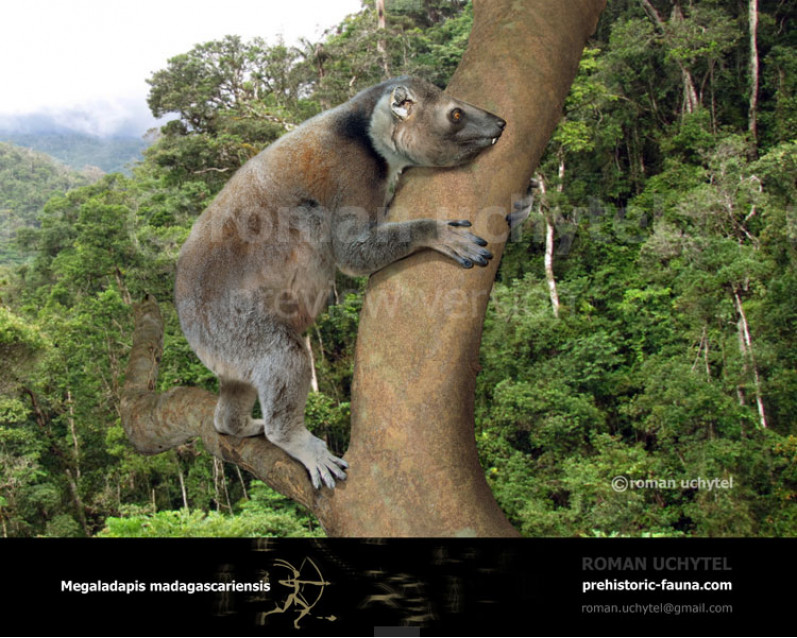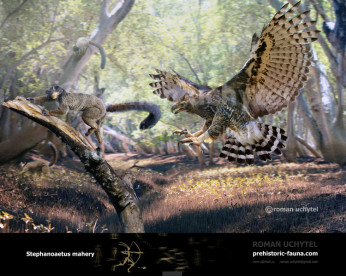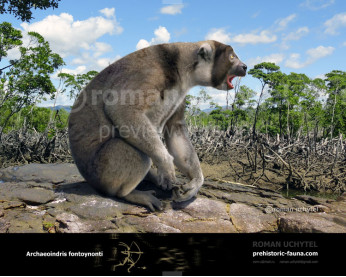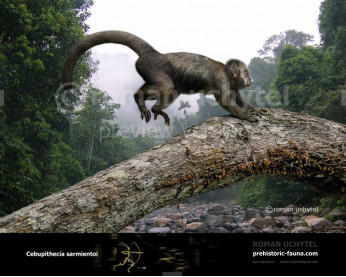Megaladapis
2828Megaladapis (Megaladapis Forsyth-Major, 1894)
Order: Primates
Family: Lepilemuridae
Temporal range: during the Late Pliocene - Holocene (Madagascar)
Dimensions: height - 150 сm, weight - 80 kg
A typical representative: Megaladapis madagascariensis Forsyth-Major, 1894
Koala lemurs, genus Megaladapis, belong to the family Megaladapidae, consisting of three extinct species of lemurs that once inhabited the island of Madagascar. The largest measured between 1.3 to 1.5 m in length. Its long arms and fingers were specialized for grasping trees, while its legs were splayed for vertical climbing. Additionally, its head was unlike any other primate, most strikingly, its eyes were located on the sides of its skull, instead of being placed forward on the skull like all other primates. Its long canine teeth and a cow-like jaw, formed a tapering snout. Its jaw muscles were powerful for chewing through the tough native vegetation. Its body weight reached a total of 50 kilograms. The shape of its skull was unique among all known primates, with a nasal region which showed similarities to those of rhinoceros, what was probably a feature combined with an enlarged upper lip for grasping leaves.
Unable to adapt to the environmental changes and the presence of humans, Megaladapis became extinct approximately 500 years ago
Megaladapis (Megaladapis Forsyth-Major, 1894)
Order: Primates
Family: Lepilemuridae
Temporal range: during the Late Pliocene - Holocene (Madagascar)
Dimensions: height - 150 сm, weight - 80 kg
A typical representative: Megaladapis madagascariensis Forsyth-Major, 1894
Koala lemurs, genus Megaladapis, belong to the family Megaladapidae, consisting of three extinct species of lemurs that once inhabited the island of Madagascar. The largest measured between 1.3 to 1.5 m in length. Its long arms and fingers were specialized for grasping trees, while its legs were splayed for vertical climbing. Additionally, its head was unlike any other primate, most strikingly, its eyes were located on the sides of its skull, instead of being placed forward on the skull like all other primates. Its long canine teeth and a cow-like jaw, formed a tapering snout. Its jaw muscles were powerful for chewing through the tough native vegetation. Its body weight reached a total of 50 kilograms. The shape of its skull was unique among all known primates, with a nasal region which showed similarities to those of rhinoceros, what was probably a feature combined with an enlarged upper lip for grasping leaves.
Unable to adapt to the environmental changes and the presence of humans, Megaladapis became extinct approximately 500 years ago

-797x638.jpg)
-797x638.jpg)

-70x56.jpg)
-70x56.jpg)




